Stay in the know on all smart updates of your favorite topics.
Vacature: Programmamaker Ruimte & Wonen bij Pakhuis de Zwijger
Senior programmamaker Ruimte & Wonen
Creëer jij graag verdiepende, toegankelijke en inspirerende programma’s die de uitdagingen van stedenbouw aansnijden? Begrijp je het belang van samenwerken met verschillende belanghebbenden om rechtvaardige oplossingen te verkennen voor complexe vraagstukken? Kan je je effectief verhouden tot zowel leefwereld (burgers, maatschappelijk middenveld, activisten, NGO’s) als systeemwereld (overheid, kennisinstellingen, bedrijven), om innovatieve programma's te ontwikkelen rondom wonen, ruimtelijke ordening en duurzaam, creatief en inclusief bouwen?
Solliciteer dan nu voor de functie van senior programmamaker Ruimte & Wonen bij Pakhuis de Zwijger.
Full-time · Pakhuis de Zwijger
Over Pakhuis de Zwijger
Pakhuis de Zwijger maakt meer dan 600 programma’s per jaar over dringende maatschappelijke vraagstukken, met rechtvaardigheid als kernwaarde. We brengen belanghebbenden samen in verschillende formats om gezamenlijk oplossingen te verkennen. Dit doen we met een team van programmamakers, producenten, communicatiemedewerkers en technici.
Wat zoeken we?
Een creatieve en daadkrachtige programmamaker met inhoudelijke kennis van stedenbouw en ruimtelijke ordening. Je hebt het vermogen om effectief te schakelen tussen verschillende belanghebbenden, van lokale gemeenschappen tot zakelijke partners, om vernieuwende programma's te ontwikkelen die het publiek bewust maken van stedelijke en ruimtelijke vraagstukken en transities verder helpen.
Als senior programmamaker draag je bij aan de strategische ontwikkeling van de programmering. Je initieert en onderhoudt partnerschappen, werkt aan opdrachten en stuurt enkele programmamakers en stagiairs aan op jouw thema. Enige ervaring met leidinggeven aan een (klein) team is dus een pré. Door kennis en presentatie heb je inhoudelijk gezag in je werkgebied.
Jouw profiel:
- Actuele kennis en een stevig netwerk op het gebied van ruimtelijke thema’s.
- Strategisch inzicht; ervaring met het onderhouden van samenwerkingsverbanden en het aantrekken van nieuwe (financiële) partners.
- Creatief, leergierig en vol met originele ideeën.
- Communicatief sterk (zowel intern als extern) en cultureel sensitief. Je hebt een sterk vermogen om je in anderen te verplaatsen.
- Beschikbaar voor 40 uur per week waarvan gemiddeld één avond per week voor het draaien van een programma.
Bij Pakhuis de Zwijger hanteren we de CAO Nederlandse podia. Deze functie is ingeschaald in schaal 7 (minimum €3.516 en maximum €4.940), de precieze inschaling is afhankelijk van ervaring en kwalificaties.
Pakhuis de Zwijger is een cultureel-maatschappelijke non-profitorganisatie. Wij streven er naar een grote diversiteit aan identiteiten en ervaringen de ruimte te geven in ons team. Daarom moedigen wij nadrukkelijk mensen van alle culturele en genderidentiteiten en opleidingsachtergronden aan om te solliciteren.
Geïnteresseerd?
Solliciteer vóór maandag 13 mei 2024 via de onderstaande link. Voor vragen kun je contact opnemen met HR-adviseur Jip Gradener via: 06-13626126.
Acquisitie naar aanleiding van deze oproep wordt niet op prijs gesteld.
Demoday #23: Co-creating with residents in the heat transition
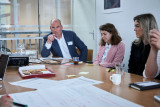
The heat transition is in full swing. Municipalities want their residents off the gas and want them to switch to renewable sources of heat. Unfortunately, heat grids have often led to frustrated residents. Which in turn has led to delayed or cancelled plans for the municipality.
Dave van Loon and Marieke van Doorninck (Kennisland) have looked into the problems surrounding heat grids and came up with a plan. In this Demoday work-session we dived into the problems surrounding heat grids and their plan to solve them. The session was moderated by our own Leonie van Beuken.
Why residents get frustrated with heat grid plans
Involving residents in the planning of a heat grid is difficult. It takes a lot of time and effort and the municipality is often in a hurry. This is why they choose for a compromise in which they already make the plan, but try to involve citizens at the end part. However, this leads to residents not having anything to say in the plans. They can block the plans, but they can’t really make changes. This leads to a lot of dissatisfaction.
This top-down approach doesn't seem to be ideal for involving residents in the heat transition. That's why Kennisland is working on developing a plan for early collaboration with residents in the heat transition of neighbourhoods, with a focus on connecting with the community's concerns.
They have seen that this kind of approach can be successful by looking at the K-buurt in Amsterdam-Zuid-Oost. In the initial stages, the first plan for the K-buurt didn't gain much traction. However, when they shifted towards a more collaborative approach, people felt empowered to engage, leading to a more meaningful participation process. Instead of traditional town hall meetings, discussions took place in community spaces like the local barber shop. This shift towards genuine participation and co-creation has resulted in a much-improved end product, one that residents truly support and believe in.
The plan for co-creation in the heat transition
The plan that Kennisland came up with consists of a few key points that are necessary for success:
• Engage with residents early on in the process.
• Also consider other issues in the neighbourhood. There might be more pressing concerns for the residents themselves.
• Ensure accessibility for everyone to participate.
• Truly collaborate on developing a list of requirements.
• Harness creativity.
• Work in a less compartmentalized manner.
They aim to form a neighbourhood alliance and organize a community council. Together a plan can be made for the neighbourhood that all residents can get behind.
This plan might take a bit longer at the start, but that investment in time will pay itself back in the end.
SWOT analysis of co-creation plan
After Dave and Marieke explained their plan we did a SWOT analysis with the group. We looked at the Strengths, Weaknesses, Opportunities, and Threats of the plan.
The main strength that was pointed out was the ability to make a plan together with the residents. The residents experience the neighbourhood differently than a government official, which makes the final plan more beneficial to everyone.
The weaknesses the group saw in the plan were mainly that this could potentially slow down the process. Should we maybe do less participation instead of more and use force to get this heat transition going?
There were a lot of opportunities identified for this plan. The quality of the plan (and the neighbourhood) can greatly increase. By slowing down at the start we can actually accelerate and improve the neighbourhood on many levels. This plan also offers a great learning experience.
Finally, we went into the threats. One of the big threats that was pointed out was the lack of trust. If residents don’t trust the municipality and the process then it will never be possible to let this plan succeed. The explanation to residents also needs to be understandable. The explanation around a heat grid can get technical very quickly, and residents often don’t have the background to understand everything. The last threat that was pointed out was that if you get a lot of input from the residents for the plan, you also have to do something with that, and still be realistic. You have to work hard to manage expectations.
We completed the session by asking the participants if they knew any partners and places to collaborate with for this plan, or if they had any other ideas to make this plan successful.
We would now like to ask the same questions to you! Do you know someone who would like to partner up with Kennisland, do you know a place where this plan can be tested, or do you have any other ideas? Let us know by contacting me at noor@amsterdamsmartcity.com.
Demoday #23 Knowledge Session: An Introduction to Socratic Design
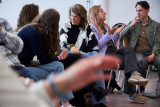
During our 23rd Demo Day on April 18, 2024, Ruben Polderman told us more about the philosophy and method of Socratic Design. It's important for a city to collectively reflect on a good existence. Socratic Design can be a way to think about this together, collectively.
Thinking and Acting Differently with Socratic Design
Together with his colleagues at the Digitalization & Innovation department of the Municipality of Amsterdam, Ruben explored how a city should deal with innovation and digitalization. Things were progressing well. The municipality could act swiftly; for example, promising Smart Mobility research and innovation projects were initiated with new partners. However, the transitions are heading in various directions, and progress remains limited. No matter how groundbreaking innovation is, there's a danger in trying to solve problems with the same mindset that caused them. The ability to perceive or think differently is therefore crucial. More crucial, even, than accumulated knowledge, as filosopher David Bohm suggested.
Through Socratic Design, we can collectively improve the latter. You work on your own presuppositions, enhance your listening skills, and deepen your understanding of our current dominant narratives to create new narratives and practices. Ruben guided us through examples and exercises to help us understand what narratives and presuppositions entail.
Narratives
"We think we live in reality, but we live in a narrative," Ruben proposes to the group. What we say to each other and how we interact creates a culture that shapes the group and its actions. Narratives are stories that guide our culture, values, thoughts, and actions. They are paradigms so deeply rooted that we no longer question them and sometimes believe there is no alternative. Our current dominant narrative has significant consequences for the Earth and humanity, and although it seems fixed, we can also create new narratives together if we choose to do so.
We must fundamentally seek a good existence within safe ecological boundaries. This should go beyond the transitions we are currently favouring, which sustain our lifestyle but just make it less harmful for the environment. If we want to create new stories with new, positive human perceptions and lifestyles, we must first examine our current narrative and presuppositions. We will need to deconstruct our current ways of living and thinking, much like the Theory U method mentioned during the previous Knowledge Session (see our recap article of this session).
Understanding Presuppositions
Ruben showed us various themes and images to collectively practice recognizing presuppositions. For example, a photo of a medical patient and doctors in action demonstrates that our feeling of "to measure is to know" is also crucial in healthcare. The doctors focus on the screen, the graph, the numbers, and therefore have less focus on the patient; the human, themselves. A photo of the stock market, where a group of men is busy trading stocks, also illustrates our idea of economic growth. Here too, there is a fixation on numbers. Ideally, they're green and going up, but meanwhile, we can lose sight of what exactly we're working towards and what exactly it is that we’re ‘growing’.
As a group, we discussed some presuppositions we could find in our field of work. For example, we talked about our need for and appreciation of objective data, and technologism; the belief in solutions rooted in technology and digitalization.
Fundamental Presupposition Shifts and New Narratives
If you flip a presupposition like Technologism and suggest that Social Interaction could be our salvation and solution to many of our problems, you set off a fundamental presupposition shift. If you translate this into practical actions or experiments, you can collectively understand how a newly created presupposition functions. As a group, we worked on this. During this session, I myself worked with an example from the field of mobility.
If I were to apply this new presupposition in the field of mobility and we look at the development of cars, perhaps we shouldn't go towards autonomous vehicles (technologism), but look for ways to motivate and strengthen carpooling (social interaction). As an experiment, you could, for example, set up an alternative to the conventional car lease plan. Employees of an organization don't all get the option to lease a car; instead, it's considered who could commute together, and there's a maximum of 1 car for every 4 employees per organization. Just like going to an away game with your soccer team on Sundays as a kid; enjoyable!
Read More
This session was an introduction and gave us a good initial understanding of this philosophy and method, but there's much more to discover. The method also delves into how presuppositions are deeply rooted in us, how we validate this with feeling in our bodies, and dialogue methods to collectively arrive at new values and narratives. There's more explained about Socratic Design on Amsterdam's Open Research platform.
Smart City - Moderne stad of digitale gevangenis

Maak jij je zorgen over je privacy en controle van de overheid? Of kan de digitale revolutie je niet snel genoeg gaan? Op woensdag 8 mei gaan we bij Argan in gesprek over de mogelijkheden en gevaren van de smart city: een stad waarbij technologie en data worden gebruikt om de stad te besturen. Een moderne stad moet slim zijn om alle problemen het hoofd te bieden, lijkt het idee. Maar wat is ‘slim’? En om welke problemen gaat het? Meld je aan voor het gesprek, stel je vragen aan het panel en praat mee!
Tijd: Inloop 19:00 - Start 19:30 - Einde 21:00
Locatie: Argan op Jan Tooropstraat 6A
Toegang: gratis
Aanmelden: https://argan.nl/upcoming-events/aanmelden/
PublicSpaces conferentie 2024
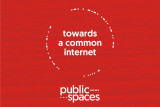
Op 6 en 7 juni organiseren PublicSpaces en Waag Futurelab de vierde editie van de PublicSpaces conferentie met als thema 'Taking Back the Internet'. Het tweedaags programma vindt plaats in Pakhuis de Zwijger. Via panels, keynotes, rondetafelsessies, lezingen, kunst en cultuur banen we ons een weg richting een internet waar we gezamenlijk de regels bepalen.
> Taking Back the Internet!
Anno 2024 is het gros van digitale diensten en platforms in handen van enkele commerciële Big Tech bedrijven. Deze centralisatie van macht is niet in lijn met hoe het internet ooit bedacht is en zorgt zelfs voor maatschappij-ontwrichtende problemen. Van privacyschending en van beïnvloeding van verkiezingsuitslagen tot discriminatie door bevooroordeelde algoritmes: het monopolie van Big Tech raakt iedereen.
Hoe herwinnen we - als burgers, organisaties en overheden - de controle op onze data en ons digitale leven? Als we zelf willen kunnen bepalen hoe ons digitale ecosysteem eruit ziet, moeten we onafhankelijk beslissingen kunnen nemen over het ontwerp, gebruik en beheer van digitale hulpmiddelen en platforms. Tijdens de conferentie gaan we daarom met sprekers, publiek en kunstenaars in gesprek over eigendom van data, privacy, interoperabiliteit, decentralisatie en meer. Kortom: technologie gebaseerd op publieke waarden.
Programma
Het complete programma wordt in de komende weken bekend gemaakt, maar de eerste namen zijn al bekend! Staatssecretaris Alexandra van Huffelen zal de conferentie openen. Futurist Karen Palmer verzorgt de opening keynote, en econoom Francesca Bria neemt ons mee in een Europese strategie voor het ontwikkelen van een ethische digitale economie. Verwacht ook bijdragen van Luna Maurer, Mieke van Heeswijk, Bert Hubert, Kumbale Musavuli, Paolo Cirio, Nanda Piersma, Roos Groothuizen, Nastia Cistakova, Astrid Poot, Paul Keller, Toshi Reagon, Julia Janssen, Jan Zuiderveld, The Hmm, Sebastian Lasse, Marlijn Gelsing, Maaike Okano-Heijmans, Reijer Passchier, Tamara van Zwol, Lashaaawn, Benjamin Fro, Marleen Stikker, en vele anderen.
De conferentie wordt dit jaar gemodereerd door Roland Duong en Abdo Hassan.
Waar? Pakhuis de Zwijger, Amsterdam
Wanneer? Donderdag 6 juni & vrijdag 7 juni 2024
Demoday #23: Mobility Injustices and the creative mind.
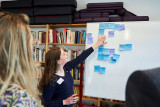
In a world where moving yourself from point A to point B is becoming much more crucial than ever, there are people out there who cannot experience such a luxury at the flick of a wrist, or perhaps the clack of an ankle? It is hard to imagine sometimes, but there are those who cannot move around as easily as others; be it because of financial, physical, vehicular, or other reasons. A community that can go about as they please without any issues is a happy community that is beneficial to society – For a collective of governments and businesses it is in their best interests to ensure citizens can experience freedom and liberty in their mobility. The question of how to achieve this freedom in mobility and how to deter against injustices regarding mobility remains a hot topic, however. On behalf of Provincie Noord Holland and in collaboration with Amsterdam Smart City and Amsterdam Centre of Expertise, a group of graduating students tackled this topic on the latest Demoday of 2024.
Starting the voyage : What are mobility injustices?
A value workshop led by Jackie Ippel and Jade Salomons engaged the participants in a fun, creative wave of brain-crackling activities. Participants were presented with a question of whether they knew what mobility injustices, or as we call it in Dutch “Mobiliteits Armoede”, was. An explanation of which followed suit soon after. Mobility Injustices, as described by the KiM organization, explains the inability or difficulties people experience in terms of reaching activity locations due to inadequate transport options, combined with socio-economic and spatial conditions in which people find themselves. As a result, they are often hindered in their participation in social life, which negatively affects their quality of life.
It is important to think about the definition of what exactly mobility injustices entail, as it helps us find a better understanding in finding a creative series of solutions that will solve this complex jigsaw puzzle.
Like a ball of yarn : unraveling theorems.
In order to stimulate the brain of each participant and to get the blood pumping through their legs, each participant was asked to stand in the middle of the room. As was once quoted in the horror thriller Saw; “Wanna play a game?”. Participants were presented with a series of theorems in which they had to make a choice that’d question their liberal thoughts; either stand on one side of the room for one answer or on the other side for the other – No in-betweens. Being forced to make ultimatums proved to be both challenging for the participants yet fun, as it was met with bountiful heaps of enthusiasm. In the first theorem, participants were presented with a question of whether or not mobility should be a fundamental right for each and every citizen. While agreed one did not, but can their minds be changed? A flurry of other theorems were presented, each of which dove deeper into the depths of dilemmas one may encounter when attempting to solve the puzzle of mobility inequality. Like who is more important, those who have low incomes or those who suffer from physical and mental disabilities which hinder their day-to-day lives? Brief discussions flowed forth after each and every theorem, after each voting round, reasons were given as to why one can choose one over the other. After which another second voting session followed. Perhaps new insights would change one’s opinion on the subject? It actually did once or twice! Such is the power of dialogue.
Embarking into the abyss : Worst Idea Possible.
“How ba-a-a-ad can I be? I’m just doing what comes naturally-“ -such were the words Onceler sung in Dr. Seuss’s ‘The Lorax’. While people do not like the idea of being bad or thinking of bad ideas sometimes this way of thinking can actually bring plentiful new insights never thought of before. The group split itself in two, each of which under the guidance of either Jackie Ippel or Jade Salomons. Participants were asked to come with their most horrid, ludicrous ideas that’d actually make mobility injustices worse. After which they had to decide what element made this a bad idea. Example, if public transport were to be described, the element that’d make the idea bad would be less alternatives for traveling. The final and third part of this exercise required something rather unique however. Does your mind already wonder what? Well, it’s quite simple really, now participants had to come up with what would be the opposite of their bad idea! So what would their idea be in reverse, an actual solution to the problem they created. If your bad solution was to make everything only scannable by QR-codes its reverse solution would be… using solely physical text! For a solid 20 minutes participants racked their heads and discussed until their times were down to only 5 minutes left. The last of those minutes left were spent discussing and laughing about their ideas – A method met with confusion at first was appreciated with loads of enthusiasm by the end where only time was the fun killer.
A creative view found in madness: Crazy Eight.
The creativity cannot just end after one session. Holding the thought of the previous session, participants were asked to gather in a circle around a table. With each given a paper and asked to fold it so that 8 separate square spaces would form on the sheet the Crazy Eight exercise was explained. Participants were asked to draw their solution one of their 8 square. For each drawing they had a minute per square, a total of 8 minutes until all were filled. Of course with so little time there was little room for thinking, imagination had to pull the cart here, which led to both silly and unique drawings. The longer the session went on the more difficult it became – the participants were truly pushed to their creative limits. A well-trained eye could even notice how some participants still tried to finish their previous drawing before moving onto the next despite the time. You could feel the atmosphere in the room shift to a hectic, almost crazy aura, thus doing its name of ‘Crazy Eight’ truly justice.
At the end of the session it was only natural that people presented their top 3 drawings. One after another each participant proudly showed off their creative drawings like a trophy to the rest of the group. Turns out, despite not communicating with one another during the drawing sessions there were lots of similarities in the elements used in each drawing. The bus, the civil servant, and the elderly were commonly used elements seen back in almost everyone’s drawing. Via these sources of inspiration it became clear just where the solutions may lie.
An journey’s end : Results.
At the end of the session we didn’t just start talking about what we had done. No, instead we At the end of the session, we didn’t just start talking about what we had done. No, instead we went back and looked at the very first theorem everyone was presented with; “Should mobility be a fundamental right for each and every citizen?”. Last time everyone answered all but one was in favor of this theorem, now participants were asked to revise their statement and see if they still agreed with what they said at the beginning. As said before, dialogue can change the outlook we have on the world and so someone did change their stance – The one person that disagreed with the theorem now actually agreed that mobility should be a fundamental right. A full 100% score! Only after this a talk about what we had done started. Opinions were asked and each participant shared the emotion they had experienced during this work session and to leave it behind on a post-it.
· Fun and insightful: The gamification of thinking is taking the design world by storm, and on this Demoday, it has proven that this form of design thinking can not only be effective in bringing brand new insights but also can be fun.
· Enthusiasm: What started off with an iffy approach ended with tons of enthusiasm. Idea generating doesn’t just have to be sitting at a table and talking in your own bubble; it can become so much more effective when the mood is changed from serious and gloomy to frivolous and enthusiastic..
· Creativity: A creative way of thinking actually helps in generating ideas. Using playful thinking such as considering a bad idea first and then the opposite helps find solutions to problems in a much more efficient way.
During this Demoday, we as a group of graduating students got to know the thought process behind those who work within the field of mobility. While we hope that we brought them plenty of insights and, above all, a fun day, it is sufficient to say that we too learned an abundance of information. The insights made during the Demoday will be used by us in writing our final report for the Provincie Noord Holland regarding a detailed consult on how to improve the mobility of the citizens of the province of Noord-Holland and how to tackle the injustices surrounding mobility. Demoday’s are fun and can inspire even the most closed-minded people. If we could, we would do it all over again. And, if you are still on the fence about joining a Demoday, then I hope that column will ignite that curiosity.
The global distribution of the 15-minute city idea 5/7
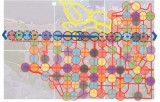
A previous post made it clear that a 15-minute city ideally consists of a 5-minute walking zone, a 15-minute walking zone, also a 5-minute cycling zone and a the 15-minute cycling zone. These three types of neighbourhoods and districts should be developed in conjunction, with employment accessibility also playing an important role.
In the plans for 15-minute cities in many places around the world, these types of zones intertwine, and often it is not even clear which type of zone is meant. In Paris too, I miss clear choices in this regard.
The city of Melbourne aims to give a local lifestyle a dominant place among all residents. Therefore, everyone should live within at most 10 minutes' walking distance to and from all daily amenities. For this reason, it is referred to as a 20-minute city, whereas in most examples of a 15-minute city, such as Paris, it is only about <strong>the round trip</strong>. The policy in Melbourne has received strong support from the health sector, which highlights the negative effects of traffic and air pollution.
In Vancouver, there is talk of a 5-minute city. The idea is for neighbourhoods to become more distinct parts of the city. Each neighbourhood should have several locally owned shops as well as public facilities such as parks, schools, community centres, childcare and libraries. High on the agenda is the push for greater diversity of residents and housing types. Especially in inner-city neighbourhoods, this is accompanied by high densities and high-rise buildings. Confronting this idea with reality yields a pattern of about 120 such geographical units (see map above).
Many other cities picked up the idea of the 15-minute city. Among them: Barcelona, London, Milan, Ottawa, Detroit and Portland. The organisation of world cities C40 (now consisting of 96 cities) elevated the idea to the main policy goal in the post-Covid period.
All these cities advocate a reversal of mainstream urbanisation policies. In recent decades, many billions have been invested in building roads with the aim of improving accessibility. This means increasing the distance you can travel in a given time. As a result, facilities were scaled up and concentrated in increasingly distant places. This in turn led to increased congestion that negated improvements in accessibility. The response was further expansion of the road network. This phenomenon is known as the 'mobility trap' or the Marchetti constant.
Instead of increasing accessibility, the 15-minute city aims to expand the number of urban functions you can access within a certain amount of time. This includes employment opportunities. The possibility of working from home has reduced the relevance of the distance between home and workplace. In contrast, the importance of a pleasant living environment has increased. A modified version of the 15-minute city, the 'walkable city' then throws high hopes. That, among other things, is the subject of my next post.
Supporting Sustainable Technology Education Through E-Waste Recycling
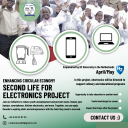
🌍✨ Join Us in Making a Difference! ✨🌍
We're excited to launch a groundbreaking project aimed at transforming e-waste into educational opportunities! 🚀📚 As part of our commitment to sustainability and digital literacy, we're collecting smartphones, laptops, and other electronics to support vibrant educational workshops in Rwanda.
Why join us? By participating, you'll:
- 🌱 Support environmental sustainability by helping reduce e-waste.
- 📖 Contribute to enhancing digital literacy among underserved communities.
- 🤝 Be part of a global movement advocating for responsible technology use.
- 🎓 Help provide essential skills that can transform lives and foster long-term growth.
We're looking for individuals and organizations to donate devices, share expertise, or sponsor our efforts. Every contribution makes a real difference, and together, we can create a more sustainable and inclusive future. 🌟
Let's reshape the future, one device at a time. Join us in this exciting journey and be credited in our upcoming documentary that highlights the collective efforts of our incredible partners from Germany, Latvia, and the Netherlands. 🎥🌍
CONTACT US THROUGH EMAIL - madaralace1999@gmail.com
OPEN CALL Placemaking Week Europe 2024

Get ready for an exciting experience at the 7th Annual Placemaking Week Europe (PWE) in Rotterdam, Netherlands, from September 24-27, 2024! 🚀
Join us as we co-create an unforgettable programme! Do you have a game-changing project, research, or workshop to share? We want to hear from you!
This year’s festival revolves around four compelling themes:
1. Creating Place & Making It Last
2. Climate Adaptation: Together Towards Change
3. Living with Water: The Flow of the City
4. Local Power & The Battle for Space
Submit your proposals by May 19, 2024, and shape the future of urban spaces with us! Don’t miss out on this opportunity to make a difference! Join us in Rotterdam and let’s build better cities, one idea at a time! ✨
You can find all the open call info and application instructions here.
More information about PWE'24 on our official website.
Highlights from the Intelligent Cities Challenge Implementation Lab

From March 4 to April 5, Amsterdam Smart City (ASC) collaborated with international peers from 77 cities across Europe in a series of online knowledge and inspiration sessions during the Intelligent Cities Challenge (ICC) Implementation Lab. The focus was on sharing best practices and building knowledge for implementing Local Green Deals (LGDs) to accelerate the transformation towards sustainability based on the principles of good governance, policy integration, partnership with local stakeholders.
Colleagues, partners, and experts from the Amsterdam Smart City network shared insights in several thematic and training sessions, including:
• Mobility & Transport Thematic Session: Pelle Menke shared the approach and lessons from ASC's Mobility Justice Challenge, while Diederik Basta introduced the City of Amsterdam's participation in the Gemini project, supporting residents in starting local, shared mobility cooperatives through a "Mobility as a Commons" (MaaC) approach.
• Local Green Deals Training Session: Egon van Wees presented Amsterdam's experience in setting up nine Impact Deals with social enterprises under the CLIMAA Local Green Deals project. The evaluation indicates that these deals have resulted in the creation of 105 jobs for people with barriers to the labor market and a reduction of 92 tonnes of CO2 emissions. Amsterdam, in collaboration with Aalborg (Denmark), also developed a framework now utilized by other cities in setting up similar Impact Deals.
• Social Economy Thematic Session: Frits Verhoef shared lessons from his involvement in two local energy cooperatives, including the pioneering work of NDSM-Energie in developing a 15MW wind park in the NoorderIJplas area, highlighting various financial and political barriers yet to be overcome. Frits also his work with MeerEnergie, a cooperative aiming to establish a heating network owned by local residents in the Watergraafsmeer district of Amsterdam, utilizing waste heat from nearby data centers.
What's Next?
Amsterdam Smart City is excited to host the ICC network in Amsterdam for a Mobility Field Visit in May, showcasing best practices for public-private collaboration in sustainable and smart mobility. We also look forward to connecting with ICC peers in person during the upcoming ICC conference in Porto in June.
More Information
For further details about the Implementation Lab and upcoming ICC activities, visit the ICC website: https://www.intelligentcitieschallenge.eu/events/icc-implementation-lab-1
Stakeholders in the Amsterdam Region interested in more information or wishing to connect to the ICC network during upcoming labs or other similar sessions can reach out to ASC International Liaison via cornelia@amsterdamsmartcity.com
The '15-minute principle' also applies to rural areas (4/7)

Due to a long stay in the hospital, I was unable to post my columns. I also cannot guarantee their continuity in the near future, but I will do my best...
In my previous post, I emphasised that urban densification should be coordinated with other claims on space. These are: expanding blue-green infrastructure and the desire to combine living and working. I am also thinking of urban horticulture. It is therefore unlikely that all the necessary housing in the Netherlands - mentioned is a number of one million housing units - can be realised in the existing built-up area. Expansion into rural areas is then inevitable and makes it possible to improve the quality of these rural areas. Densification of the many villages and small towns in our country enable to approach them from the '15-minute principle' as well. Villages should thereby become large enough to support at least a small supermarket, primary school and health centre, but also to accommodate small businesses. A fast and frequent public transport-connection to a city, to other villages and to a railway station in the vicinity is important.
A thorny issue is the quality of nature in the rural area. Unfortunately, it is in bad shape. A considerable part of the rural area consists of grass plots with large-scale agro-industrial use and arable land on which cattle feed is grown. Half of the Netherlands is for cows, which, incidentally, are mostly in stalls. Restoring nature in the area that is predominantly characterised by large-scale livestock farming, is an essential task for the coming decades.
The development of sufficiently dense built-up areas both in cities and villages and the development of new nature around and within those cities and villages is a beckoning prospect. This can be done by applying the idea of 'scheggen' in and around medium-sized and large cities. These are green zones that penetrate deep into the urban area. New residential and work locations can then join the already built-up area, preferably along existing railway lines and (fast) bus connections. These neighbourhoods can be built in their entirety with movement on foot and by bicycle as a starting point. The centre is a small densely built-up central part, where the desired amenities can be found.
In terms of nature development, depending on the possibilities of the soil, I am thinking of the development of forest and heath areas and lush grasslands, combined with extensive livestock farming, small-scale cultivation of agricultural and horticultural products for the benefit of nearby city, water features with a sponge function with partly recreational use, and a network of footpaths and cycle paths. Picture above: nature development and stream restoration (Photo: Bob Luijks)
Below you can link to my free downloadable e-book: 25 Building blocks to create better streets, neighborhoods and cities
😀Is betrokkenheid van de gemeenschap de moeite waard? Enquête van 1 minuut😀

Hallo allemaal, Fijne Donderdag, 😀 (English below)
Wij willen graag begrijpen en leren oof participatie in de gebouwde omgeving de moeite waard is en welke uitdagingen je daarbij bent tegengekomen.
Vul deze enquête van 30 seconden (max. 1 minuut) in en kijk wat andere professionals ervaren.
Thank you,
Playground Team
www.plgrnd.city
----------------
Hello all, Happy Thursday, 😀
We would like to understand and learn if participation in the built environment is worth it and what challenges you have experienced with it.
Please complete this 30-second (max 1 minute) survey and see what other professionals experience.
Cheers,
Playground Team
Cursusdag 'Werken aan een lerende organisatie'
Stel je voor: je werkt in een team waarin iedereen actief bijdraagt aan verbeteringen en innovatie. In plaats van weerstand tegen nieuwe werkwijzen, denken je teamleden hierover mee. Werknemers dragen zelf actief ideeën aan om het bedrijf en zichzelf verder te ontwikkelen. Samen breng je de organisatie naar een hoger niveau.
Dat is hoe een lerende organisatie eruitziet. Maar hoe krijg je dat voor elkaar? BouwLab R&Do vertelt je er alles over in de eendaagse training van de Smart Makers Academy. Tijdens de volledig verzorgde cursusdag op 25 april laten we je zien hoe je een lerende organisatie vormgeeft en een leerplan opstelt dat past bij jouw bedrijf. Na deze dag kun je zelfs kiezen voor persoonlijke begeleiding om de implementatie binnen jouw organisatie te versterken.
Wat maakt een lerende organisatie zo belangrijk? Het gaat niet alleen om individuele ontwikkeling, maar om een gedeelde visie waarbij elke medewerker bijdraagt aan de vooruitgang. We gaan, onder leiding van Wilfried Hoffman, dieper in op dit aspect tijdens de cursusdag en leggen uit waarom een lerende organisatie essentieel is voor succes op lange termijn. Met behulp van concrete activiteiten krijg je praktische handvatten aangereikt om zelf aan de slag te gaan.
Deelname aan de cursusdag bedraagt €49,50
De cursusdag duurt van 09:00 tot 17:00 uur.
Is community engagement worth it? 1 Minute Help

Hallo allemaal, Fijne woensdag, 😀 (English below)
Wij willen graag begrijpen en leren oof participatie in de gebouwde omgeving de moeite waard is en welke uitdagingen je daarbij bent tegengekomen.
Vul deze enquête van 30 seconden (max. 1 minuut) in en kijk wat andere professionals ervaren.
Cheers,
Playground Team
----------------
Hello all, Happy Wednesday, 😀
We would like to understand and learn if participation in the built environment is worth it and what challenges you have experienced with it.
Please complete this 30-second (max 1 minute) survey and see what other professionals experience.
Cheers,
Playground Team
www.plgrnd.city
Floating Urban Development Challenge; Co-creating imaginable, workable and attractive scenarios

Due to lack of space and climate change, the future of living might need to partly move on to water areas. In our history of conquering the water, the Dutch have a head start in some of the challenges associated with living on- and with water. Researchers and designers are therefore imagining and conceptualizing floating urban development. However, to make it a truly realistic and imaginable future scenario, there are more hurdles to overcome. To realize floating neighborhoods, we’ll need to find solutions for more than only the technical aspects, like; financing, community support, ecological aspects, affordability, politics, etc.
Overcoming these barriers will be difficult. We’re currently focusing on urgent (housing)crises and our collective belief on urban development is mainly focused on ‘family apartments on land’. This challenge revolves around creating imaginable and workable scenarios of urban development on water.
Cooperative challenge: How can we help to mainstream energy cooperatives and ensure that structures in society make room for them and barriers are resolved?
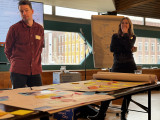
In the past decade, we have witnessed a surge of cooperatives across society. From community-led energy projects to endeavours in collective mobility and housing, citizens and companies are increasingly organizing themselves to shape their surroundings, often driven by sustainability and social goals and most of them do this in a not for profit way. Despite this rich history and the ongoing proliferation of initiatives, cooperative efforts and their benefits often remain small-scale and localized and, in most cases, accessible only to specific and select demographics.
This challenge aims to help civil society organizations in the energy domain, such as energy cooperatives, to become more mainstream. We aim to create recognition, to create an understanding of mutual interests with the key stakeholders they have to work with, and to exchange knowledge for these organizations to grow faster or repeat.
Creatieve Krachtsessie
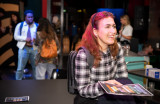
In deze kennissessie verkennen we de kracht van ontwerpbenaderingen bij het aanpakken van complexe maatschappelijke vraagstukken in nauwe samenwerking met overheden.
Overheden en andere publieke instellingen werken hard aan grote maatschappelijke vraagstukken waar ontwerpers tot op heden nog te weinig bij worden betrokken. En dat terwijl inzet van een ontwerpende aanpak bij maatschappelijke vraagstukken grote potentie heeft. Ontwerpers zijn bij uitstek opgeleid om integraal, iteratief, en met een frisse, kritische blik naar problemen te kijken. Ze beschikken bovendien over een gereedschapskist vol creatieve methodes waarmee niet-conventionele oplossingsrichtingen gezocht kunnen worden.
De ontwerpende wereld met haar creatieve aanpak en de ambtelijke procedures van de institutionele wereld gaan echter niet altijd goed samen. Wederzijds onbegrip of onbekendheid staan een goede samenwerking regelmatig in de weg. En het verbeelden of verkennen van mogelijke toekomsten is een goed begin, maar hoe kunnen die visies ook daadwerkelijk landen in een complexe wereld met ingesleten gedrag, ingewikkelde procedures, en uiteenlopende belangen?
De Staat van het Internet 2024 met Kim van Sparrentak
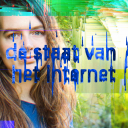
Tijdens de Staat van het Internet 2024 steekt Waag Futurelab samen met de Gemeente Amsterdam en de OBA de peilstok in het internet. Met dit jaar: Kim van Sparrentak, lid van het Europees Parlement voor GroenLinks en nauw betrokken bij Europese regelgeving ter beteugeling van Big Tech.
Kim van Sparrentak over Europa en grip op technologie
Bij de Staat van het Internet steekt Waag jaarlijks de peilstok in het internet. De lezing wordt tijdens dit Europees verkiezingsjaar gegeven door Kim van Sparrentak, lid van het Europees Parlement. Hier was ze onder meer betrokken bij de AI Act, het initiatiefvoorstel over ‘verslavend ontwerp van online diensten’ en maakt ze zich hard voor het terugdringen van de macht van Big Tech door de ontwikkeling van wet- en regelgeving.
Europa worstelt met het grip krijgen op grote sociale mediabedrijven die dicteren hoe onze digitale publieke ruimte eruitziet en gebruikt wordt. Via een aantal ingrijpende Europese wetten is er afgelopen jaren geprobeerd de macht van Big Tech terug te dringen en grip van Europeanen op hun digitale leven te vergroten. Welke impact hebben deze gehad? Welke vrijheden zijn er gewaarborgd? En wat merken inwoners van Europa concreet van wetgeving als de GDPR (AVG), Digital Service Act, Digital Market Act of AI act?
Over Kim van Sparrentak
Kim van Sparrentak Kim studeerde Politicologie en Urban Environmental Management en was tijdens haar studie actief als duovoorzitter bij DWARS Amsterdam. Na haar studie werkte ze als onderzoeker en als campaigner bij Milieudefensie en WISE, en als duovoorzitter voor de Jonge Groenen (FYEG). Daar vertegenwoordigde ze meer dan 10.000 groene jongeren in Europa. Kim is sinds 2019 Europarlementariër voor GroenLinks.
30 jaar Waag Futurelab & grip op technologie
Dit jaar bestaat Waag Futurelab 30 jaar. Van het eerste ‘sociale medium’ De Digitale Stad, toegankelijk voor een breed publiek, via het ontwerpen van een duurzame modulaire Fairphone, of de eerste opleiding voor Biohackers in Europa, tot aan een advies aan de staatsecretaris voor Digitale Zaken en een burgermeetnetwerk in Noord-Holland: al 30 jaar werkt Waag aan grip op technologie voor iedereen. Die grip op technologie staat dit jubileumjaar centraal, in onze verhalen en in onze programmering.
Geld zou geen belemmering moeten zijn om te leren over manieren om ons internet te verbeteren. Als de toegangsprijs je verhindert aanwezig te zijn, stuur dan een e-mail naar tanja@waag.org, zodat we ervoor kunnen zorgen dat je De Staat van het Internet kunt bijwonen.
De Staat van het Internet 2024 wordt georganiseerd door Waag Futurelab, de Openbare Bibliotheek Amsterdam (OBA) en de Gemeente Amsterdam.
<em>Mediapartner van de Staat van het Internet is: De Groene Amsterdammer.*
Data Dilemma's verslag: Data voor leefbare straten, buurten en steden
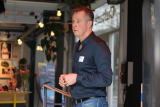
Hoe zetten we Data in voor leefbare straten, buurten en steden? En heb je die datasets echt zo hard nodig? "Of heb je de bewoner al voor je, kun je aan tafel, en kun je gewoon samen van start gaan met een idee?" (aldus Luc Manders).
Op 29 februari kwamen we in een volle Culture Club (Amsterdamse Hogeschool voor de Kunsten) bijeen om het te hebben over Data en Leefbare Wijken. In een fijne samenwerking met onze partner Hieroo en SeederDeBoer nodigden we verschillende sprekers en onze communities uit op het Marineterrein Amsterdam.
Leefbare wijken op de kaart en het visueel maken van data.
Sahar Tushuizen en Martijn Veenstra (Gemeente Amsterdam) namen verschillende kaarten mee om ons te laten zien hoe visuele data weergaven worden ingezet bij het maken van verstedelijkingsstrategieën, omgevingsvisies en beleid.
Een stad is opgebouwd uit verschillende wijken en gebieden. Simpel gezegd; in sommige wijken wordt vooral ‘gewoond’, in andere gebieden vooral gewerkt, en in sommige wijken vindt er een mooie functiemenging plaats. Samen zorgt dit voor een balans, en maakt het de stad. Maar vooral de wijken met een functiemix maken fijne wijken om in te leven, aldus Sahar en Martijn. Door de spreiding van functies visueel te maken met kaarten kan je inzichtelijk maken hoe het nu is verdeeld in Amsterdam, en inspelen op de gebieden waar functiemenging misschien wel erg achterloopt. Stedelijke vernieuwing is uiteindelijk ook een sociaal project. Het gaat niet alleen over stenen plaatsen, we moeten het ook koppelen aan bereikbaarheid en/van voorzieningen.
Sahar en Martijn gebruiken hun kaarten en gekleurde vlekken om de leefbaarheid van wijken terug te laten komen in Amsterdamse visies. Maar de kaarten vertellen niet het hele verhaal, benoemen ze op het einde van hun presentatie. “We gaan ook in gesprek met inwoners hoe functies en buurtactoren worden ervaren en gewaardeerd”. Dit maakte een mooi bruggetje naar de volgende twee sprekers.
Welzijnsdashboard.nl
Hebe Verrest (Professor aan de Universiteit van Amsterdam) nam ons daarna mee in het verhaal van welzijnsdashboard.nl. Een samenwerkingsproject tussen Amsterdamse buurtbewoners (Venserpolder) en onderzoekers van de UvA.
Dit project vond haar oorsprong in twee ontwikkelingen: Er zijn de bewoners die zich niet altijd kunnen herkennen in het beeld dat over hun wijk en economisch welzijn bestaat, en zich niet gehoord voelen in verbeterprocessen in hun eigen omgeving. En dan zijn er ook de wetenschappers die merkten dat data over levens vaak nauw economisch gestuurd is. De data en het meten ervan gebeurt op een hoog schaalniveau, en dus vroegen onderzoekers zich af hoe je op lokale schaal kunt meten met meetinstrumenten die van nature democratischer zijn.
Onderzoekers van de UvA en bewoners van de wijk Venserpolder (Amsterdam Zuid-Oost) creëerden daarom samen een dashboard. De bewoners mochten meedenken wat het dashboard allemaal voor functies had, en het belangrijkste; ze mochten samen de variabele indicatoren bedenken die ze van belang vonden voor de buurt. Met behulp van de samengestelde indicatoren konden ze hun (persoonlijke) ervaringen vertalen naar data over de leefbaarheid en staat van hun buurt. De bewoners ervaarden meer zeggenschap en gehoor, en werden steeds beter in het werken met het dashboard en het vertalen van persoonlijke ervaringen naar wat algemenere data. De onderzoekers leerden met het dashboard over het ophalen van subjectieve, maar bruikbare data. En ten slotte was het voor beleidsmedewerkers en experts een mooie middel om een mix van ‘verhalen uit de buurt’ en abstractere data te verkrijgen.
Het project loopt nog steeds en zal worden toegepast op verschillende buurten. Voor nu sloot Hebe haar presentatie af met een belangrijke learning: "Wat de bewoners belangrijke variabelen vinden, lijken ook die te zijn waar een probleem speelt".
Van data naar datum
Ten slotte hield Luc Manders (Buurtvolk) een inspirerend pleidooi over zijn ervaringen met interventies in kwetsbare wijken. Hoewel data zeker bruikbaar kan zijn voor het signaleren en voorspellen van problemen, wilde hij het publiek tonen dat het uiteindelijk vooral gaat om het in gang zetten van een dialoog en interventie, samen mét de buurtbewoners.
Data kan zeker bruikbaar zijn voor het signaleren en voorspellen van problemen. Het in kaart brengen van risico’s in wijken kan ons tonen waar actie nodig is, maar uiteindelijk gaat leefbaarheid en welzijn over een geleefde werkelijkheid. Het gevaar is dat we blindstaren op data en kaarten en dat we de kaarten ‘beter’ maken, in plaats van iets echt in gang zetten in de wijk zelf. Want ook daar waar de cijfers verbetering aangeven, kunnen nog steeds dingen spelen die we niet weten te vangen met onze data en meetinstrumenten.
Luc noemde zijn presentatie daarom ‘Van data naar datum’. We zouden het iets minder mogen hebben over data, en het méér moeten hebben over de datum waarop we van start gaan met een project, een initiatief of een dialoog met buurtbewoners. Het liefst gaan we zo snel mogelijk met de bewoner aan tafel en zetten we iets in gang. Het begint bij het delen van verhalen en ervaringen over de situatie in de wijk, deze gaan verder dan cijfers die hoogover zijn opgehaald. Dan kan er samen met de bewoners worden nagedacht over een interventie die de wijk ten goede zou komen. Luc benadrukte hierbij ook dat we nog in te korte termijnen denken. Projecten van 2 jaar en professionals die zich 2 jaar in een wijk vastbijten vinden we al een mooie prestatie. Maar interventies in het sociaal domein hebben langer nodig. We zouden moeten denken in investeringen van bijvoorbeeld 10 jaar, zo kunnen we samen met bewoners meer leren van elkaar en meer vertrouwen op bouwen, en hoeven we niet steeds het wiel opnieuw uit te vinden.
Luc deelde ervaringsvoorbeelden, waarbij kleine interventies positieve bij-effecten in gang zetten, en moedigde het publiek aan: "Kosten en investeringen zullen aan de voorkant komen en blijven. Maar blijf het langdurig doen, leer samen met de bewoners, en denk aan het sneeuwbaleffect dat kleine interventies in gang zetten".
Dank aan de sprekers voor hun verhalen en het publiek voor de levendige discussies na afloop. Wil je bij onze volgende Data Dilemma's zijn? De volgende editie van deze serie open events vindt plaats op 30 mei. Het onderwerp en de sprekers worden binnenkort bekendgemaakt via ons platform en LinkedIn. Tot dan!
Looking for people to interview for Thesis Project titled: "Inclusion in Smart Cities"
My name is Arshitha and I am currently a Master's student at the University of Twente, I am doing my thesis on the topic of 'Inclusion in Smart Cities'.
I am currently looking for researches or members of the city administrations or NGOs in Amsterdam, Barcelona and Hamburg who are interested in participating in a research interview for my Master Thesis Project.
The study's main objective is to look further into actual strategies of digital and social inclusion initiatives that can be implemented for the development of a Smart City that is inclusive and accessible to it’s citizens. I want to get real-life insights and learn about the barriers that organizations in the implementation of digital inclusion projects and use to it make a reference framework for my thesis project.
The interviews will be semi-structured and I hope to complete it by the end of April 2024. It should not take more than an hour or an hour and a half.
If you are interested in participating, please send me an email at:
a.r.jayasinghrajaflorence@student.utwente.nl
Phone Number: +31 645213887
Stay up to date
Get notified about new updates, opportunities or events that match your interests.

